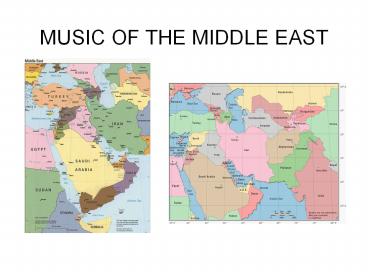MUSIC%20OF%20THE%20MIDDLE%20EAST - PowerPoint PPT Presentation
Title:
MUSIC%20OF%20THE%20MIDDLE%20EAST
Description:
... tradition of instrumental religious music or religious dance (with exception of some sects) ... theoretical writings about music. Monophonic or heterophinc ... – PowerPoint PPT presentation
Number of Views:102
Avg rating:3.0/5.0
Title: MUSIC%20OF%20THE%20MIDDLE%20EAST
1
MUSIC OF THE MIDDLE EAST
2
Major Cultural Influences
- Persian culture (Iran, speak Farsi, adheres to
Shia interpretation of Islam historic Persian
Empire) - Arabic culture (Saudi Arabia, Syria, Iraq
Lebanon, Egypt, Kuwait speak Arabic) - Turkish culture (Turkey, present day Afghanistan
speak Turkic historic Ottoman Empire)
3
Major Religions
4
The Ottoman Empire (1299-1922)
5
Persian Empire (550 BC 651 AD)
6
Influence of Islam
- Arose in Arabia in 7th century was unifying
force among Arabic tribes. Arabic language and
culture begin to absorb Persian.
7
Islam and Music
- Koranic chant. Emphasis on written word (Koran is
revealed word of God). Koran is important source
for poetry, literature and song texts. - Example of Koranic chant.
- No tradition of instrumental religious music or
religious dance (with exception of some sects).
8
Classical Music of Iran
TAR
NEY
KAMANCHE
SANTOUR
ZARB / DONBAK
SETAR
9
Music Theory
- Dastgah
- a mode, similar to Greek modes (but not limited
to half and whole steps) - 7 primary, 5 secondary
- Basis for composition and improvisation
- Includes pitches, scale patterns, melodic essence
(motif). Each has descriptive name and associated
character - Gusheh
- subdivision of a dastgah central nuclear
melody - Radif
- Repertoire of several hundred melodies or gushehs
in all 12 dastgahs memorized by students and used
as basis for improvisation and composition
10
Khandan/Musiqi Continuum
Musiqi
Khandan
Unacceptable
Acceptable
Dance music (esp. belly dance) Highly
rhythmic Precomposed Professional Ensemble Instrum
ental
Chant Unmetered Improvised Amateur Solo Vocal
11
Persian Classical Music
- Transmitted in private concerts.
- Role of improvisation.
- Texture monophonic or heterophonic.
- Melodies usually ornamented.
- Tense vocal quality.
- Section of concert devoted to one dastgah
12
Classical Concerts
- Section of concert explores a particular dastgah
(usu. five instrumental or vocal pieces) - Concerts
- Open with rhythmic introductory piece (like
Pishdaramad) - Avaz (improvised, nonmetric) (considered high
point of concert) - Concluding section (rhythmic dance or light vocal)
13
Traditional 19th century Iranian court musicians
playing kamanche, dombak, dayere, tar, santour
14
Indian and Persian Classical Music
- Similarities
- use complex system of pitches
- have long history of performance and theoretical
writings about music - Monophonic or heterophinc
- Transmitted in concerts
- Passed on in oral tradition
- Incorporate improvisation and composition
- Differences
- Persian tradition has no equivalent of tala
- Ambivalent attitude of Islam towards music
15
Persian Carpets
Persian Calligraphy
Persian miniature (Tabriz School, 13th cent.)
EXAMPLES OF PERSIAN ART FORMS






























